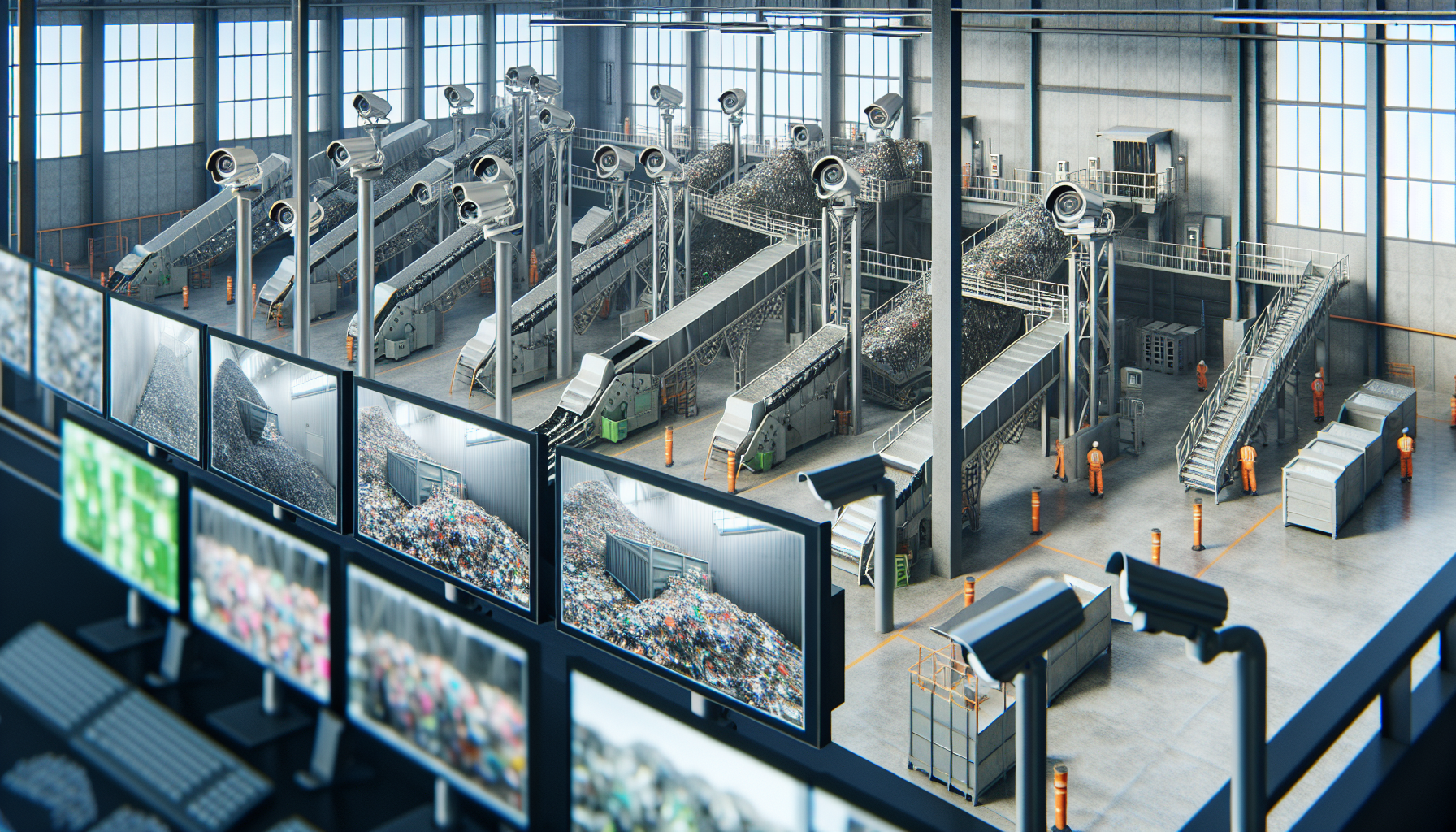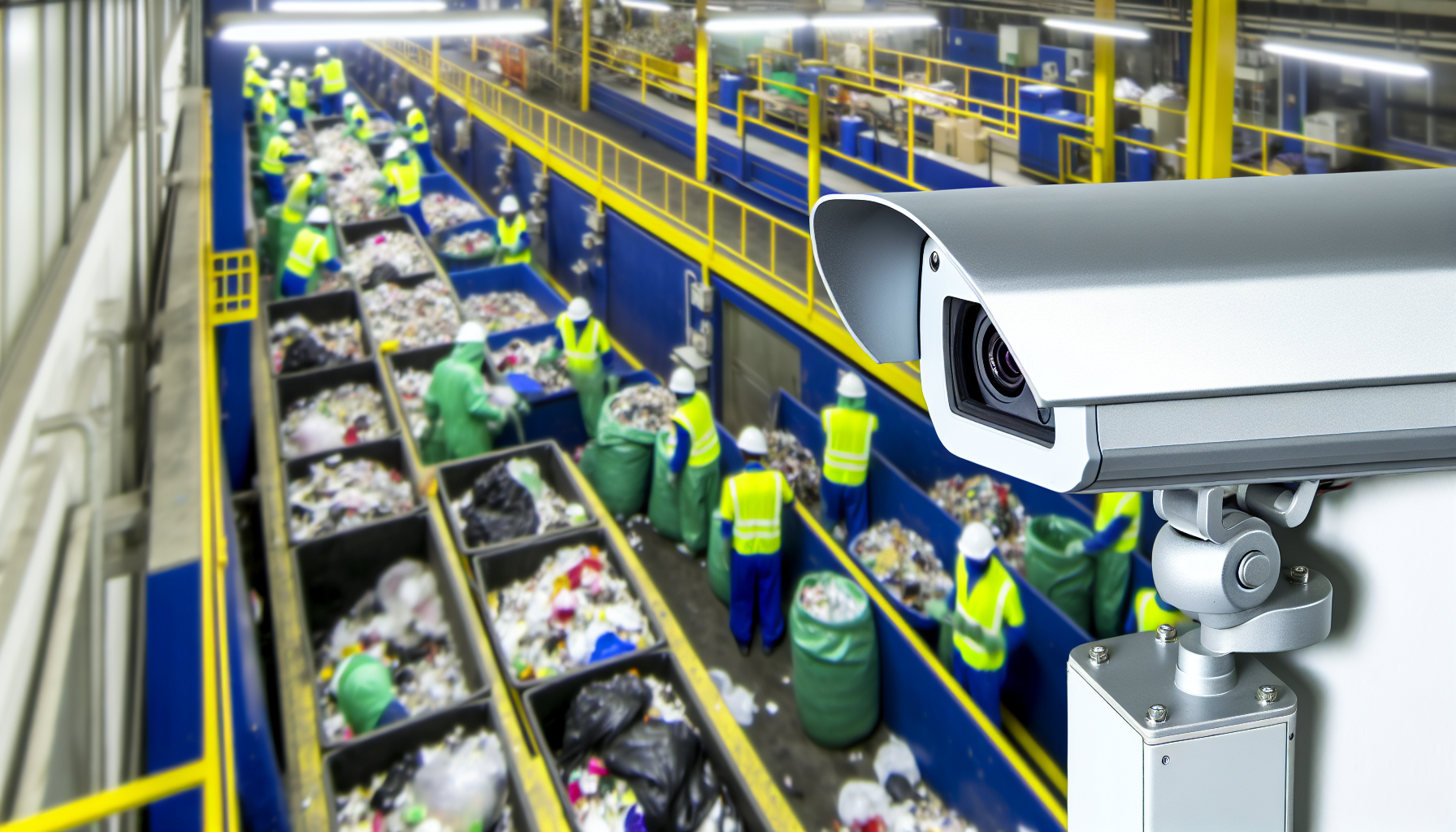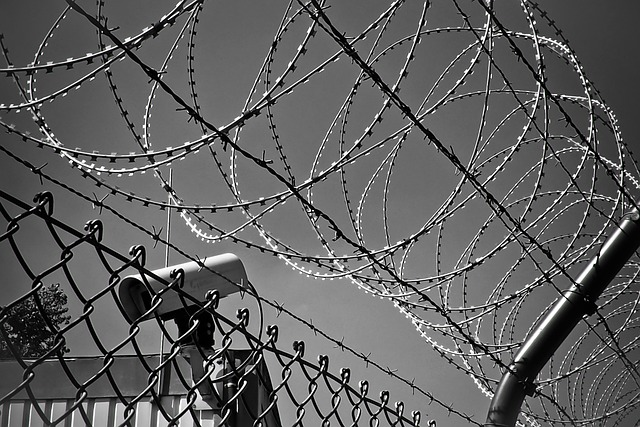In the recycling industry, recycling real time video monitoring is essential for preventing theft, ensuring safety, and maintaining regulatory compliance. This article dives into the critical role these surveillance systems play in monitoring facilities around the clock. Learn about the specific technologies that enhance facility security and how they can be integrated into your operations.
Key Takeaways
- Real-time video monitoring in recycling facilities enhances security by deterring theft, vandalism, and ensuring compliance and safety through continuous surveillance and rapid response capabilities.
- Customized video surveillance solutions, including high-resolution, thermal, and pan-tilt-zoom cameras tailored to a facility’s unique requirements, offer extensive coverage and advanced monitoring to prevent theft and improve operational efficiency.
- Advanced security technologies such as remote monitoring, access control integration, and analytics like motion detection and license plate recognition provide proactive and efficient measures for securing recycling facilities against unauthorized access and potential threats.
The Importance of Real Time Video Monitoring in Recycling Facilities

Imagine having a pair of eyes that never blink, ensuring continuous surveillance of your recycling facility. This is the level of security that real-time video monitoring offers. Why does this matter so much for recycling facilities? The answer lies in the unique challenges these facilities face, including theft, vandalism, and the need for stringent compliance and safety measures.
Integrating real-time video monitoring into a recycling facility’s security system can significantly mitigate these challenges. With the ability to promptly detect and respond to unauthorized entries, real-time video monitoring deters potential threats, minimizes business loss, and safeguards assets. We should examine the ways it achieves these benefits.
Theft Prevention
In recycling facilities, theft is a recurring concern. With valuable recyclable materials at stake, the facilities become attractive targets for criminals. However, real-time video monitoring serves as a powerful deterrent. By using strategically positioned high-quality security cameras, trained operators can:
- Spot suspicious activities
- Promptly respond
- Prevent potential thefts
- Safeguard valuable assets.
The efficacy of this method is demonstrated by a real-life episode in which a security expert apprehended a thief using live video surveillance at a recycling center. Not only did this prevent material loss, but it also demonstrated the value of partnering with reliable security companies and the efficacy of real-time video monitoring in deterring theft.
Vandalism Deterrence
Vandalism can disrupt operations and result in costly damages. Real-time video monitoring, however, can deter potential vandals by providing continuous surveillance through video streams. The idea of being watched and the likelihood of being caught can dissuade vandals, maintaining the integrity of the facility.
Common forms of vandalism, like graffiti and property damage, can be prevented using real-time video monitoring. This capability is especially valuable in environments with low visibility where thermal cameras can detect potential issues or intruders based on heat signatures. Thus, partnering with a reliable security company offering virtual guard services can significantly enhance the effectiveness of these measures, making the facility secure and cost-effective.
Compliance and Safety
All businesses, including recycling facilities, must adhere to industry regulations. Real-time video feeds facilitate continuous video monitoring and incident documentation, thereby serving as valuable evidence for regulatory compliance.
Besides, real-time video monitoring helps detect safety hazards by providing live surveillance that can recognize risky situations in real-time. For instance, it can identify hazards at access points or within the facility, thus helping in taking proactive measures to reduce potential safety incidents.
Customized Video Surveillance Solutions for Recycling Facilities

Though real-time video monitoring is efficient, it doesn’t suit all scenarios. Each recycling facility has unique security requirements, necessitating a customized approach. This is where personalized configurations that incorporate high-resolution cameras, thermal cameras, and pan-tilt-zoom cameras come into play. These technologies offer extensive coverage and monitoring designed to meet the specific needs of the facility.
High-resolution cameras provide clear, detailed images for accurate identification. Thermal cameras detect heat signatures, enabling efficient monitoring in low-light conditions. Pan-tilt-zoom cameras offer flexible coverage, allowing operators to focus on specific areas of interest. We should examine in detail how these technologies bolster the security of recycling facilities.
High-Resolution Cameras
In the world of video surveillance, image clarity is king. High-resolution cameras offer an improved image quality and clarity that significantly enhances surveillance capabilities. For recycling facilities, this precise and detailed imaging facilitates accurate identification and monitoring.
By offering detailed information on material type, high-resolution cameras also significantly improve sorting accuracy. This is crucial for effective recycling operations. Technological advancements such as hyperspectral cameras and high spectral resolution further enhance the performance of these cameras, making them an excellent investment for recycling facilities.
Thermal Cameras

Imagine a surveillance system that can effectively monitor even in low-light or obscured conditions. This is precisely what thermal cameras offer. Thermal cameras, by sensing heat signatures, allow for efficient monitoring in challenging conditions that may stump traditional cameras.
These existing cameras are especially valuable in safeguarding recycling and scrap yards and ensuring the detection of fires through unusual heat patterns. This capability prompts swift action to maintain safe working conditions, making thermal cameras an integral part of a recycling facility’s security system.
Pan Tilt Zoom Cameras
Pan-tilt-zoom cameras, or PTZ cameras, are a boon for recycling facilities with large areas. These multiple cameras provide versatile surveillance capabilities by allowing operators to:
- Pan the camera to scan a wide area horizontally
- Tilt the camera to adjust the vertical viewing angle
- Zoom in or out to focus on specific areas of interest during surveillance operations.
This dynamic control allows for comprehensive monitoring and enhances the effectiveness of surveillance in recycling facilities.
Their ability to cover a wide range of angles and distances makes them ideal for monitoring large areas. Furthermore, their dynamic control allows for comprehensive monitoring and focus on specific areas of interest, making PTZ cameras a valuable addition to video surveillance systems in recycling facilities.
Remote Monitoring and Access Control
In the digital age, security measures have evolved beyond physical boundaries. Remote monitoring and access control integration are two such advancements that have revolutionized security in recycling facilities. Remote monitoring allows for efficient oversight of multiple locations, providing real-time security updates and proactive notifications, while access control integration restricts entry to authorized personnel only in specific areas, enhancing security and preventing unauthorized access.
Through remote monitoring and access control integration, recycling facilities can achieve improved security and efficiency, avoiding unnecessary travel or continuous manual oversight. However, the benefits of these technologies don’t stop here.
Remote Video Monitoring by VirtuGuard™
Remote video monitoring by VirtuGuard™ offers several benefits for overseeing your recycling facility:
- It allows you to monitor your facility from any location at any time.
- It provides dependable monitoring around the clock.
- It aids in the detection and identification of potential threats or theft.
- It distinguishes between various types of movement.
With remote video monitoring, you can have peace of mind knowing that your facility is being monitored effectively by a video surveillance system.
The decrease in manual monitoring both saves resources and boosts the security system’s efficacy. The technology also facilitates real-time alerts and security monitoring, keeping the facility management informed about any abnormal events or activities occurring within the surveillance area.
Access Control Integration
Imagine a simple card swipe limiting access to sensitive areas within your facility to only authorized personnel. Such is the capability of access control integration. When combined with video surveillance systems, it enhances security by preventing unauthorized access.
Access control integration is crucial in recycling facilities to:
- Mitigate unauthorized access to hazardous materials
- Enhance the overall security for staff, equipment, and assets
- Limit access to ensure that only authorized individuals can enter restricted areas
- Enhance security and accountability
Advanced Analytics for Proactive Security Measures
In the quest for enhanced security, the role of data cannot be understated. In recycling facilities, advanced analytics like motion detection, video review, and license plate recognition facilitate proactive security steps. These technologies analyze surveillance data to provide actionable insights and automate security responses.
Motion detection triggers real-time alerts on identifying movement, video review and verification help identify false alarms and provide video evidence for law enforcement and insurance purposes, while license plate recognition aids in tracking vehicles entering and exiting the facility. We should further examine these technologies.
Motion Detection
In video surveillance systems, motion detection is a revolutionary technology. This technology analyzes consecutive frames of video to identify differences that may indicate movement. When motion is detected in the field of vision, cameras start recording, thus conserving storage space and reducing the need for continuous monitoring.
In addition to conserving storage space, motion detection facilitates real-time alerts to users, keeping them informed about any abnormal events or activities occurring within the surveillance area. With recognition accuracies as high as 99%, motion detection offers a high level of precision in identifying potential security threats.
Video Review and Verification
Another potent instrument for improving security in recycling facilities is video review and verification. This process involves:
- The examination of video footage by trained personnel to confirm ongoing events
- If necessary, notify the relevant authorities
- This serves to offer visual evidence of any unauthorized activities occurring on the premises.
The role of video verification is especially significant in identifying false alarms. By offering supplementary information and enabling monitoring center staff to assess the video footage, these technologies ensure that law enforcement is only alerted to genuine threats.
License Plate Recognition
For tracking vehicles that enter and exit recycling facilities, License Plate Recognition (LPR) technology is a useful tool. By automating monitoring and surveillance, aiding in deterring crime, and capturing essential video footage for accountability purposes, LPR enhances security in recycling facilities.
Key elements of LPR systems include a specialized camera with infrared capabilities, Optical Character Recognition technology, and Automatic License Plates Recognition software algorithms. These elements work together to decode and record license plate information, enhancing security in recycling facilities.
Choosing the Right Security Solution for Your Recycling Facility
The decision to select the appropriate security solution for your recycling facility is vital, as it can greatly influence the security, efficiency, and overall profitability of your facility. But how do you navigate the myriad of options available? The process involves three key steps: assessing security risks, evaluating technology options, and partnering with a reliable security provider.
Assessing security risks helps you understand the unique challenges your facility faces, while evaluating technology options allows you to choose security solutions that best meet your needs. Finally, partnering with a reliable security provider ensures consistent, high-quality security services. We should examine each of these steps in detail.
Assessing Security Risks
Understanding your facility’s unique security risks is the first step in choosing the right security solution, including physical security measures. Potential risks include:
- Exposure to harmful chemicals
- Moving vehicles
- Improperly secured material bales
- Moving machinery
Failing to address these risks can result in:
- irreparable reputational damage
- fines
- licensing issues
- compromised confidential data
- a negative public image
- financial losses
- staffing problems
- legal issues
- data exposure
Hence, before selecting a security solution, it’s essential to comprehensively evaluate your facility’s security risks.
Evaluating Technology Options
After assessing the security risks, you should proceed to evaluate technology options. This involves identifying factors that could influence the efficacy of the selected technologies and prioritizing the ranking of recycling technologies as a significant determinant of the recycling center’s success.
The most effective security camera systems in recycling facilities encompass remote monitoring solutions, mobile surveillance trailers, and explosion-proof cameras. Current advancements in security technology include the integration of fill-level sensors, smart bins, material quality assessing sensors, automated sorting systems, advanced asset tracking technologies, and increased focus on data privacy and security.
Partnering with a Reliable Security Provider
Partnering with a trustworthy security provider is the last step in selecting the suitable security solution for your recycling facility. A dependable provider improves real-time video monitoring capabilities by providing advanced live remote video surveillance systems specifically designed to safeguard the facility from theft or damage, complementing the presence of live security guards.
When choosing a security provider, it’s important to consider factors such as:
- Reputation
- Credibility
- Reliability
- Affordability
- The provider’s ability to train security guards to use technology
- Company ownership
- Customer service
- Reviews
- Licensing and insurance
- Service response time
- The quality of materials, equipment, and facilities
- Contract terms
- Financing options
- The provider’s level of experience and expertise in comparison to other security companies.
Summary
In the dynamic and challenging environment of a recycling facility, security cannot be an afterthought. Thankfully, advancements in technology have made it possible to implement robust and efficient security solutions such as real-time video monitoring. From preventing theft and deterring vandalism to ensuring compliance with regulations, this technology offers numerous benefits.
Whether you’re considering high-resolution cameras for clear imaging, thermal cameras for low-light conditions, or pan-tilt-zoom cameras for flexible coverage, the key to enhancing security lies in choosing the right security solution. By assessing security risks, evaluating technology options, and partnering with a reliable security provider, you can ensure a secure and efficient environment in your recycling facility.
Frequently Asked Questions
Can old video cameras be recycled?
Yes, old video cameras can be recycled along with other types of cameras like film, digital, and disposable cameras as well as cellphone cameras. Many camera recycling programs accept all kinds of cameras.
Why is real-time video monitoring important for recycling facilities?
Real-time video monitoring is important for recycling facilities because it helps prevent theft, deter vandalism, and ensure compliance and safety.
What are the benefits of high-resolution cameras in recycling facilities?
High-resolution cameras in recycling facilities allow for accurate identification and monitoring due to clear and detailed images. This helps improve overall efficiency and accuracy.
How do I choose the right security solution for my recycling facility?
To choose the right security solution for your recycling facility, assess security risks, evaluate technology options, and partner with a reliable security provider.

